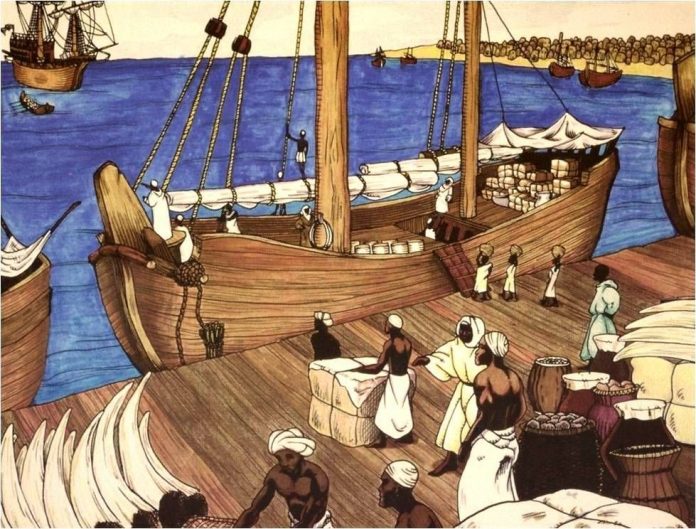When looking at the evolution of Black business you must begin with Africa. Mother Africa – the continent that gave birth to the evolution of humanity, civilization, and commerce and trade. Commerce and trade? Yes. The first humans on Earth, Africans were the first to develop economic systems and engage in international trade.
According to renowned African scholar Cheikh Anta Diop and others, ancient Africa was organized politically, socially and economically. Ancient African nations developed systems of commerce, production, distribution, currency, taxes and land ownership. The story begins in ancient Kemet (Egypt), Kush (Nubia) and Axum (Ethiopia).
Some scholars mark the inception of trade in ancient Kemet to the Pre-dynastic Period (6000 BCE — 3150 BCE). Although these nations began as agrarian societies, the invention of more sophisticated tools spurred the evolution of agrarian societies to include more sophisticated agricultural production and the domestication of animals. The invention of new tools allowed Kemet to develop irrigation systems and build granaries (public warehouses) where citizens were allowed to store excess grains. The granaries could also be viewed as a bank since surpluses were used as payment for laborers and craftsmen who worked on public projects. Kemetans also began to use their surpluses to barter for other commodities.
Kemet began trading with other kingdoms along the Nile River under Pharaoh Menes. Trade was conducted through the barter system with each commodity having a fixed price. However, it was Queen Hatshepsut, the fifth pharaoh of Kemet, who initiated and expanded intercontinental trade. She led an expedition to Punt in 1493 BCE. She also directed the construction of large ships that crossed the Red Sea and the Sinai Peninsula carrying linen, grain, and papyrus to Punt, cities along the Dead Sea and Eilat in the Gulf of Aqaba. Kemet began sailing expeditions to establish new trade partners and find commodities to improve the kingdom. Pharaoh Thutmose III followed Hatshepsut’s lead by leading trade expeditions to Southwest Asia and the Mediterranean.
Kush (Nubia), located to the south of Kemet between 2000 BCE and 350 AD, was conquered and influenced by Kemet early in its history, but eventually conquered Kemet and ruled as its 25th Dynasty (716 BCE and 654 BCE). One of the richest gold-bearing empires of the ancient world, Kush was one of the world’s principal sources of gold. Kushites also were experts in iron smelting and metalwork. Kush controlled the supply of ivory, ostrich feathers and wood to Kemet. Kush traded with its immediate neighbors and the international community, and traveled as far as the Persian Empire and Rome for trade. Kushite traders sold cattle hides for weapon holsters and clothing, in addition to selling commodities like precious stones, ebony, exotic animals, iron products, hardwood and grain. Kush was eventually conquered by Axum round 350 CE.
The Axumite Kingdom which existed between the 1st Century CE and the 8th Century CE was vitally important to the ancient world because of its commercial achievements. Axumite territory expanded into Southern Arabia and Yemen in the 6th Century CE. Axum had a strong navy that protected the coastal trade routes and networks along the Nile and the Southern Red Sea. Axum society was known for its complex market economy. Commodities like labor, slaves, ivory, incense, and other goods, were bartered or exchanged using legal tender. Trade activities in Axum have been linked to China, Persia, Rome and Byzantium, and it was considered one of Rome’s biggest trading partners during the 3rd and 4th centuries CE. Axum’s merchants traveled across India and Arabia trading in the most sought after commodities in the ancient world including emeralds, ivory, incense, exotic animals, gold, silk, salt, obsidian, and spices, which were then sold to their neighbors in Nubia, Kemet and kingdoms in inner Africa. Axum is also known for creating a coin system during the reign of King Endubis (270 CE) that became elaborate under King Ezana (315CE –356CE).
In West Africa, the Ghana (300CE –1076CE), Mali (1050CE – 1488CE) and Songhay (1355CE – 1591CE) empires were leaders in commerce and trade. By the 10th Century CE, Ghana had gained control of the southern section of the western Trans-Saharan trade route.
Sundiata, the founder of the Mali Empire is often credited with expanding its territory. By the time of his death in 1255, Mali controlled the sources of most of the important articles of trade including the salt mines of Taghaza, the copper mines of Takedda, the gold mines to the south, and important trading towns like Walata, Jenne, and Gao. Mansa Musa who ruled Mali between 1312 and 1337, is revered as one of its greatest rulers and is renowned for his pilgrimage to Mecca in 1324-25 during which he visited Cairo. It’s said that he gave away so much gold during the pilgrimage that it caused its devaluation in Kemet. The pilgrimage attracted traders and Muslim scholars to Mali, who helped further the economic and cultural development of the empire, especially in Timbuktu – one of West Africa’s most important centers of trade. In Songhay, the last of the great empires of the Western Sudan, Sunni Ali (1464-1492) brought Timbuktu under the control of the Songhay Empire through a series of successful campaigns that included the conquest of Mali.
The Trans-Saharan trade was vital to the development of all of these African empires. Because of their locations, they provided key commercial trading centers where commodities were exchanged.
Read Part II, ScoopVIZION, April 15, 2021
The Evolution of Black Business (Part I)
Reading Time: 3 minutes


